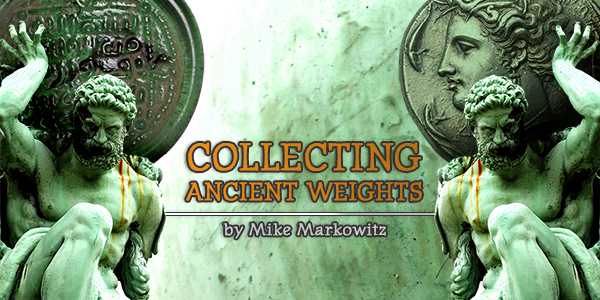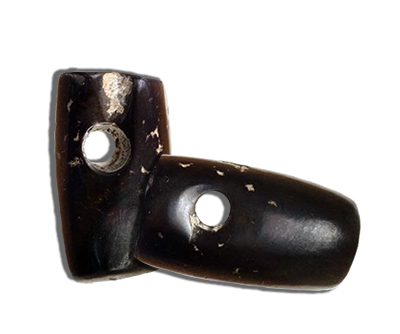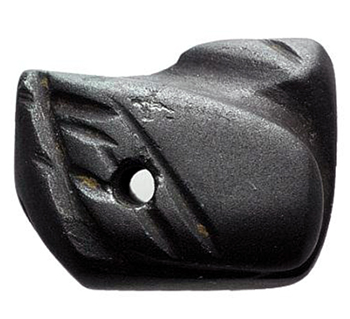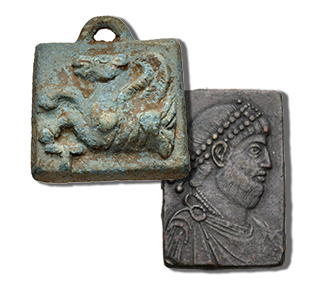
By Mike Markowitz for CoinWeek …..
Do not use dishonest standards when measuring length, weight or quantity. Use honest scales and honest weights, an honest ephah and an honest hin[1].
— Leviticus, 19:35-36
PEOPLE ARE NOT VERY GOOD at estimating or comparing weight. Before the rise of market economies, people measured commodities mainly by volume – a “handful” or a “heap” was close enough. But as rare spices and precious metals became important in commerce, the need for precision measurement emerged, with standards for even extremely minute amounts.
Ancient commercial weights made of stone, bronze, lead or glass survive in considerable numbers, and they often appear as collectibles in major numismatic auctions.
The equal-arm pan balance was probably invented around 3000 BCE in Mesopotamia to facilitate trade by weighing small objects against accepted standard weights. A famous illustration from the Egyptian Book of the Dead[2] (c. 1285 BCE) shows the “weighing of the heart” on an enormous pan balance. If the heart of the deceased in the afterlife balanced a feather, then it was judged to be free from the weight of sin.
On many Roman coins Aequitas, the personification of fairness, holds a pan balance as her symbol. A pan balance appears on every US banknote as part of the Treasury Department seal.
Ancient Mesopotamian weights were based on grains of barley, a staple of life in the Fertile Crescent. Barley was baked into cakes or brewed into beer (much of the region was too hot for growing wheat[3].) One hundred eighty barley grains (about 0.046 grams) equaled one shekel (8.4 g). Sixty shekels made one mina (504 g). Sixty minai made one talent (30.2 kg). The Phoenicians and the ancient Hebrews adopted the Mesopotamian system of weights and measures (which is why we see so many references to shekels and talents in the Old Testament).
Barley grains grown in different seasons under different conditions vary in weight, so it is not surprising that different local standards proliferated. There are at least 15 standards for the weight of a shekel, ranging from seven to 17 grams!
Stone Weights
 Some of the earliest commercial weights were made of hematite, a reddish-black mineral that takes a fine polish[4]. Cylindrical in shape and pierced to string on a cord, they are sometimes catalogued as beads. They are difficult to date precisely, since the form remained unchanged for centuries. In a 2015 auction, a pair of half-shekel hematite weights from Phoenicia dated from the 15th to 11th century BCE or later, sold for just US$95.
Some of the earliest commercial weights were made of hematite, a reddish-black mineral that takes a fine polish[4]. Cylindrical in shape and pierced to string on a cord, they are sometimes catalogued as beads. They are difficult to date precisely, since the form remained unchanged for centuries. In a 2015 auction, a pair of half-shekel hematite weights from Phoenicia dated from the 15th to 11th century BCE or later, sold for just US$95.
Hafford (2005) analyzed a set of weights from the 1922-1934 excavation of Ur in Iraq. The 14 small bits of banded agate stored in a museum basement were labeled as “unfinished beads”. He found the weights followed a modified Fibonacci series (1, 1, 2, 3, 5, 8, 13…), a mathematical sequence frequently found in nature in which each term is the sum of the previous two[5]. Theoretically, this is the most logical and compact sequence for balance weights.
In Egypt and Mesopotamia, stone weights were often carved as ducks or geese, with their necks resting on their backs. A beautifully carved Mesopotamian duck weight 14 cm long brought $21,500 in a 2011 New York auction, against an estimate of $5,000-7,000 (apparently a record for an ancient stone weight)[6].
 In ancient Judaea, dome-shaped limestone weights had flat bottoms so they would sit in a balance pan without rolling. Some were inscribed with numerals or the name of the unit. In a recent New York sale, a set of 16 Judaean stone weights ranging from two grams to 116 grams sold for an impressive $11,500. Most date from the ninth to seventh centuries BCE[7].
In ancient Judaea, dome-shaped limestone weights had flat bottoms so they would sit in a balance pan without rolling. Some were inscribed with numerals or the name of the unit. In a recent New York sale, a set of 16 Judaean stone weights ranging from two grams to 116 grams sold for an impressive $11,500. Most date from the ninth to seventh centuries BCE[7].
Metal Weights
The Greeks, who traded with the Phoenicians, adopted elements of their weight system. Most Greek weights were cast lead. There were competing standards, but the political and economic ascendance of Athens made the Athenian drachma of 4.32 grams very influential. The mina was 100 drachmai, and the talent was 60 minai, or 6,000 drachmai. Excavation of the Athenian agora (marketplace) over many years, has lead to the discovery of numerous lead commercial weights. Often inscribed with the name of the unit or simply a numeral (Greeks used letters of their alphabet as numerals), many have a symbol, such as a dolphin, turtle, owl, wheel or vase (Lang and Crosby).
A handsome Greek lead weight dated to sometime in the fourth to third centuries BCE, possibly from Lampsakos, bears an image of Pegasus. Weighing just over 100 grams, it brought $525 in a recent auction[8].
The Romans adopted many things from their Greek neighbors, including their system of weights. The Roman pound (libra) of about 327 grams had 12 ounces (unciae), each of about 27 grams or eight drachmai. Roman coinage regulations often specified how many coins of a particular type were to be struck from a pound of precious metal. The gold aureus was struck at 60 to the pound, while the solidus, introduced by Constantine I in 312 CE, was struck at 72 to the pound.
 Official bronze weights (exagia) were used to test whether coins had been clipped or adulterated. A rare solidus weight of the emperor Julian II (360-363 CE) brought $3,000 in a recent New York auction[9].
Official bronze weights (exagia) were used to test whether coins had been clipped or adulterated. A rare solidus weight of the emperor Julian II (360-363 CE) brought $3,000 in a recent New York auction[9].
Numerous exagia survive from the time of emperors Theodosius I, his sons Arcadius and Honorius, and his grandson Theodosius II (c. 379 – 450). A superb example brought 17 thousand Swiss francs (about US$17,730) in a 2008 European auction – possibly a record price for a Roman weight[10].
Beginning in the late fourth century, bronze commercial weights in the Eastern (“Byzantine”) Empire were often inlaid with silver numerals, symbols or imperial portraits. On many surviving examples, all or part of the silver has been pried out, so weights with full silver inlays command a premium from collectors. A fine Byzantine fourth century Byzantine weight is inscribed “N S”–meaning six nomismata (equivalent to one ounce)–with six small silver crosses, indicating the number. In a recent European auction, it brought $213[11]. A prized example from my own collection bears an elaborate cross in a wreath, flanked by the Greek letters “Γ A” (gamma alpha), meaning one ounce. This weight, once in the collection of Hollywood actor Adolphe Menjou (1890-1963) bears gouges where the silver inlay was pried out[12].
Glass Weights
As early as the sixth century, official coin weights were made of glass[13], a durable material that would nevertheless crack or break if there was any attempt at tampering. Byzantine glass weights are rare. A nice seventh-century example sold for $550 in a 2007 New York auction[14].
The Muslim world, however, adopted glass weights enthusiastically, and they were produced in green, blue, white, brown and other colors with elaborate calligraphic inscriptions. The Walters Museum in Baltimore has a massive one-pound glass weight from Damascus made in 743 CE–one of the earliest dated Islamic objects in an American museum.
 A beautiful one-dinar coin weight (4.73 grams) from the Muwahhid caliphate of North Africa and Spain (1121-1269 CE) brought UKP 550 (US$712) in a recent London auction[15], but nice collectible examples can be found for under $100.
A beautiful one-dinar coin weight (4.73 grams) from the Muwahhid caliphate of North Africa and Spain (1121-1269 CE) brought UKP 550 (US$712) in a recent London auction[15], but nice collectible examples can be found for under $100.
Ancient and medieval commercial weights presents a fascinating challenge to the collector: there are few standard reference works in English, weights are difficult to date, and they may be hard to distinguish from other kinds of antiquities (such as tokens, beads and seals).
A Crucial Numismatic Component
Metrology — the study of weights and measures — has always been something that classical numismatists need to understand. It is astonishing to many beginning collectors that ancient mints were able to control the weight of precious metal coins to within a few milligrams plus or minus (for comparison, an aspirin tablet weighs 350 milligrams). “Base metal” or copper alloy coins were generally over-valued in terms of their metal content so there was no need to control the weight of each piece so precisely.
The exact weight of a coin is usually irrelevant to collectors of modern machine-made coins, which do not vary appreciably from well-established standards. But the weight of an ancient coin is a critical part of its description, possibly helping to establish its authenticity–as well as its date and origin. Today we weigh coins on digital electronic scales that give us a readout at the press of a button. But in ancient mints and markets, coins and bullion were weighed on simple pan balances, using sets of official weights.
Ancient commercial weights, particularly those that were used to weigh coins, are therefore of interest to many collectors.
* * *
Notes
[1] The ephah was a measure for grain, equal to about 22 liters. The hin was a measure for liquids equal to 3.8 liters, or about a gallon.
[2] https://en.wikipedia.org/wiki/Book_of_the_Dead
[3] The grain of wheat was the basis of many medieval weight systems. The English grain weighs 0.06478 gram.
[4] https://en.wikipedia.org/wiki/Hematite
[5] Named for the Pisan mathematician Leonardo Fibonacci (c. 1125 – 1250): https://en.wikipedia.org/wiki/Fibonacci_number
[6] Christie’s Antiquities Auction, 9 June 2011, Lot 26.
[7] The New York Sale XXXIX, 10 January 2017, Lot 1.
[8] Classical Numismatic Group (CNG) Electronic auction 399, 14 June 2017, Lot 172.
[9] Heritage NY Signature Sale 3037, 4 January 2015, Lot 30159.
[10] Numismatica Ars Classica (NAC) Auction 46, 2 April 2008, Lot 739.
[11] Roma Numismatics, Auction XIII, 23 March 2017, Lot 1062.
[12] Private purchase at Whitman Baltimore Winter Coin Expo, November 2009. $150.
[13] https://en.wikipedia.org/wiki/Byzantine_glass
[14] The New York Sale XIV, 10 January 2007, Lot 497.
[15] Baldwin’s Auction 4, 9 May 2017, Lot 411.
References
Bendall, Simon. Byzantine Weights: An Introduction. London (1996)
Berriman, Algernon Edward. Historical Metrology: A New Analysis of the Archaeological and the Historical Evidence Relating to Weights and Measures. New York (1953)
Hafford, William. “Hanging in the Balance: Precision Weighing in Antiquity”, Expedition 47 (2005)
Klein, H. Arthur. The Science of Measurement: A Historical Survey. New York. (1988)
Lang, Mabel and Margaret Crosby. Weights, Measures and Tokens: The Athenian Agora, 10. American School of Classical Studies at Athens (1964)
Powell, Marvin A. “Money in Mesopotamia”, Journal of the Economic and Social History of the Orient 39:3 (1996),
Ronen, Yigal, “The Enigma of the Shekel Weights of the Judean Kingdom”, Biblical Archaeologist 59:2 (1996),
Ronen, Yigal, “The Weight Standards of the Judean Coinage in the Late Persian and Early Ptolemaic Period”, Near Eastern Archaeology 61:2 (1998)
Scott, R. B. “Weights and Measures of the Bible”, Biblical Archaeologist 22:2 (1959)
Whitelaw, Ian. A Measure of All Things : The Story of Man and Measurement. New York (2007)
NGC-Certified Ancient Jewish Coins Currently Available on eBay
[wpebayads]




